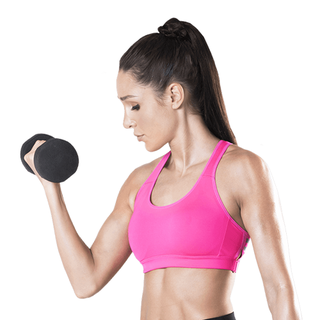How To Stop Muscle Cramps

October 23, 2018

I’ve had a few people reach out to me wanting to know how to stop muscle cramps during exercise.
I completely understand how uncomfortable it can be when you’re in the middle of a workout or taking a walk and suddenly you get hit with a cramp that makes it difficult to move.
Jump to:
After reading this blog, you should know how to stop muscle cramps from upsetting your workouts. Plus, I’ve included a list of foods to help prevent muscle cramps too — keep reading to find out what they are!
What causes muscle cramps?

Whether it is a leg cramp, a cramp in your toe or even a cramp in your abdominals, this feeling can quickly put a stop to any workout! But what actually causes cramps to occur?
Muscle cramps happen when your muscle forcibly contracts involuntarily. This can happen at night, while you are exercising or during your daily activities — the time that it occurs often depends on the cause of the muscle cramp.
Muscle fatigue is a common cause of cramping, both during a workout and when you are resting. Because exercise stimulates muscles and causes them to contract and lengthen, cramps can happen when your muscles become tired. This then makes it harder to ‘turn off’ muscle contraction.
If you tend to get muscle cramps during workouts in hot weather, this can be a sign of dehydration muscle cramps. Basically, your body is losing fluids, which means it doesn’t have enough sodium and electrolytes, which are vital for functionality. This can then affect nerve function, causing muscles to contract involuntarily.
How to stop muscle cramps
Sadly, there is no way to completely stop muscle cramps from ever happening but there are some effective methods for reducing the chance of cramping.
Try these tips to prevent muscle cramps:
Drink your water!
Dehydration has many negative effects on your body, including cramping. Make sure you are getting enough H20 every single day, especially during and after your workout to replenish lost fluids.
Warm up and cool down
This helps prepare your body for a workout.
Foam roll
Adding foam rolling to your routine helps increase circulation, boosting the blood flow to your muscles and cells.
How do you treat muscle cramps?

While the tips above are great for helping to prevent muscle cramps, sometimes you need a quick way to treat them when they come on!
When a cramp hits mid-workout, try out one of these tips:
- Gently stretch the muscle that is cramping.
- Take a break from the pace of your workout and rest until the cramp stops.
- If it’s not too painful, give the muscle that’s cramping a massage. That can help to relax the area and stimulate blood flow.
Regular training can also be really helpful for keeping muscle cramps at bay, especially if you are training for a marathon or a specific event. By slowly building your fitness up, and training specifically to match your goals, you are helping to prepare your body and mind for what is to come. That way, you aren’t pushing your body too hard, too fast. This can also minimise your injury risk, so it is really important that you focus on steady progression.
Foods that help with muscle cramps
So, what are some of the best foods for muscle cramps?
What you eat and drink can play a role in how your body handles many processes, including nerve and muscle function. Having a deficiency, or a shortage, of the vitamins and minerals your muscles need to function can lead to cramping, which is why it is important to eat a well-balanced, vitamin-rich diet.

Here are a few foods that can help to reduce the risk of cramping:
Watermelon
It’s not just the high water content that helps replenish your body! Watermelon also contains natural sugars which help to restore glycogen levels.
Bananas
We know that bananas can make us happier but did you know they can also help stop muscle cramps too? Bananas contain potassium, which your muscles need for sustained contraction during exercise. Potassium is an electrolyte, something your body loses when it sweats. This can lead to muscle cramping.
Pumpkin seeds
Thanks to the magnesium they contain, pumpkin seeds help assist muscles contract and relax normally during exercise.
Sweet potato
Another source of potassium, sweet potato helps ensure proper functioning of your nervous system and muscles.
Green leafy vegetables
Muscle contraction and nerve impulses drive your body during exercise, so it is important these systems can function effectively. Your body needs calcium to help with that, so make sure you get plenty of leafy greens!
Stop muscle cramps in their tracks!
Your body is a very complicated and impressive system! For it to function effectively, you should be taking care of it as best you can. That means resting when you need to, fuelling your body with the right foods and listening to your body too.
I hope this blog helps you to put an end to muscle cramps spoiling your workout!